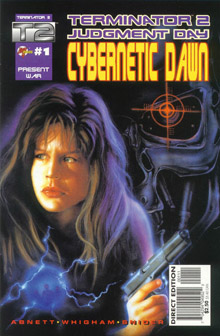For some reason, the first further adventures based on “Terminator 2: Judgment Day” didn’t come out until four years after the film. In a nice bit of synergy, though, that meant Malibu Comics’ “Cybernetic Dawn” (1995-96) was released in the same year the film is set.
The five-issue “Cybernetic Dawn” (numbered 1-4, then concluding with Issue 0) features a standard plot of three Terminators popping up the day after “T2” to ensure the creation of Skynet. But writer Dan Abnett’s characterizations and dialog are spot-on. I can practically hear Linda Hamilton’s voice giving the narration. Abnett also gets Dyson’s wife and two children back into the story, setting the stage for Danny’s involvement in the sequel, “Nuclear Twilight.”
Meanwhile, artists Rod Whigham and Jack Snider nail the likenesses of the actors, further giving “Cybernetic Dawn” a cinematic feel. The series feels more commercial than Dark Horse’s work, but by that same token, it feels more like a bedrock element of the saga.
CHARACTERS
John Connor: He’s in the same emotional place as in “T2” – 10 years old and on the run from Terminators with his mom.
Sarah Connor: She’s caught between 1) running away and protecting her son (Sarah’s survivalist instinct) and 2) meeting with the Dysons to explain what happened (a notion she picks up from her son).
Kyle Reese: Dead for 11 years, and 15 years away from being born.
Detective Mossberg: First introduced in “T2,” he gets thrown into the mix with Sarah and company, and she tasks him with taking John and the Dysons to Sarah’s mountain hideout in Mexico while she pays a visit to NetWork Developments.
The Dyson family: Miles’ wife, Tarissa, and two kids, Danny and Blythe, are scared and miserable. Danny brings up an interesting idea to John: Perhaps Skynet could be killed with a computer virus.
Dr. Silberman: He’s in a straightjacket, picking up from the “T2” novelization, where he went cuckoo after experiencing the events in the mental hospital.
Detective Weatherby: Mossberg’s partner from “T2” likewise now believes Sarah’s horror stories about the future. But he bites the dust at the hands of a Terminator.
TERMINATORS
Two T-800s and a T-1000: Their time bubble appears in the middle of the road a day after the climactic events of “T2.” Their goals, as always, are to make sure Skynet gets built. The T-1000 takes the guise of a woman working for NetWork Developments, essentially the new Cyberdyne. Skynet will deploy this strategy again in “The Sarah Connor Chronicles” through a T-1001 in the guise of Catherine Weaver (Shirley Manson).
Inoperative endoskeletons at the NetWork Developments facility: NW possesses 27 endoskeletons from the future. The first one was found in Argentina in the 1970s. NW also believes the Chinese have three and the French have one. (Then again, Sarah gets this information from a T-1000, so take it for what it’s worth.)
CONTINUITY
“Cybernetic Dawn” picks up immediately after “T2,” in 1995.
In a “T2” deleted scene and the movie’s novelization, Sarah tells the Salceda family to go into hiding. But apparently they are slow packers. In a flashback, we see that the T-1000 found them, resulting in Enrique’s death.

NetWork Developments (the new Cyberdyne, but even more bluntly corporatist, with federal agents ensconced in the company) discovers the T-800 arm in the steel factory in Issue 1. This seems consistent with the “T2” movie, but it contradicts the novelization, where Sarah throws the arm into the molten pit.
NetWork Developments is the third incarnation so far of scientists engaging in reverse engineering of Terminator tech, following Dr. Hollister and his cronies in Dark Horse’s 1984 saga and Miles Dyson in “T2.”
Sarah sends Mossberg, John and the Dysons to Sarah’s “place in the mountains,” where she was living during the time of “Secondary Objectives” in 1984.
John removes the microchip from one of the T-800s they kill. And our heroes acquire the head of the other T-800 endoskeleton. Keep these elements in mind for the sequel, “Nuclear Twilight.”
TIME TRAVEL
In Issue 1, a time bubble containing two T-800s and a T-1000 appears in the middle of an L.A. highway a day after the climactic events of “T2.” It’s unexplained, at least in this story, what future year and what TDE facility they came from.
As a way to test its TDEs, Skynet sent many endoskeletons back to various points in time (Issue 4). Twenty-seven inoperative endoskeletons end up at NetWork Developments, three with the Chinese and one with the French. Perhaps the successful endoskeletons went into hiding as time passed and then met up with Skynet at a pre-planned date in the future, thus confirming that the TDEs work – at least sometimes.
“Cybernetic Dawn” finds Sarah and John doing a lot of mulling about fate and free will, in dialog or narration. But since they are limited by their own experiences, and because Kyle didn’t understand “that tech stuff” either, they can’t know the rules of timelines for sure. Still, “Cybernetic Dawn” is heavily fate-oriented, with the characters essentially preparing for a future of war against the machines.
Evidence for “fate”:
- In Issue 1, John thinks his continued existence (as opposed to winking out of reality) is proof that Skynet will win. This is because Skynet is the catalyst for Kyle going back in time and fathering John.
- In Issue 3, after Sarah and John dispatch one of the T-800s, Sarah believes its existence “is proof that the Skynet future is still a fact.”
- By the end of the conclusive Issue 0, Sarah believes Skynet is a certainty, not so much because she’s figured out time-travel rules, but because she sees how hard it is to kill Skynet in its embryonic stages: “No matter how many times we delay its creation, there will always be someone eager to step in and finish what’s been started, just to see if they can. We are our own worst enemy. The nuclear twilight will come.”
Evidence that “the future is not set”:
- In Issue 1, Sarah mulls the idea of, if not a rewritable timeline, then at least alternate timelines: “I guess if the future isn’t set, then there must be one version where Skynet will exist. And one where we have won.”

